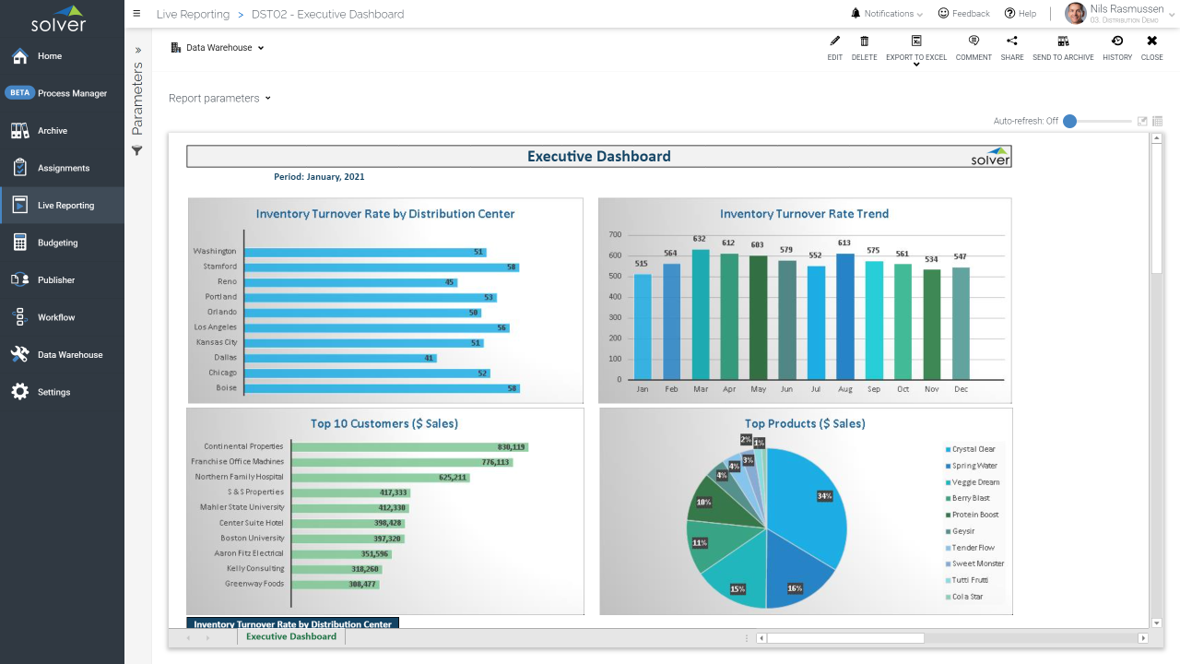Executive Dashboard for a Distribution Company
What is
an
Executive Dashboard for a Distribution Company
? Executive dashboards are considered important analysis tools and are used by upper management to review overall performance as it relates to sales and inventory key performance indicators (KPIs). Some of the main functionality in this type of dashboard is that it combines four KPI charts with a report section. The charts covers: 1) Inventory turnover by distribution center, 2) Inventory turnover trend by month, 3) Top 10 customers based on sales, and 4) Top 10 best-selling products. The report section at the bottom of the charts contains the related metrics in a table format. You find an example of this type of dashboard below.
Purpose of
Executive Dashboards for Distributors Distribution businesses use Executive Dashboards to provide self-service analysis that enables quick and easy monitoring of sales and inventory metrics. When used as part of good business practices in an executive department, a company can improve the speed and agility of decisions and it can reduce the chances that executives lack important insight between formal corporate meetings.
Executive Dashboards
Example Here is an example of an Executive Dashboard with sales and inventory KPIs. [caption id="attachment_21257" align="alignnone" width="1180"]
 Example of an Executive Dashboard for a Distribution Company[/caption] You can find hundreds of additional examples
here
Who Uses This Type of
Dashboard
? The typical users of this type of dashboard are: CEOs, COOs, CFOs.
Other
Dashboard
s Often Used in Conjunction with
Executive Dashboards for Distributors Progressive executive department sometimes use several different Executive Dashboards, along with general sales dashboards, inventory reports, profit & loss reports, cash flow statements, balance sheets and other management and control tools.
Where Does the Data for Analysis Originate From? The Actual (historical transactions) data typically comes from management systems or enterprise resource planning (ERP) systems like: Microsoft Dynamics 365 (D365) Finance, Microsoft Dynamics 365 Business Central (D365 BC), Microsoft Dynamics AX, Microsoft Dynamics NAV, Microsoft Dynamics GP, Microsoft Dynamics SL, Sage Intacct, Sage 100, Sage 300, Sage 500, Sage X3, SAP Business One, SAP ByDesign, Acumatica, Netsuite and others. In analyses where budgets or forecasts are used, the planning data most often originates from in-house Excel spreadsheet models or from professional corporate performance management (CPM/EPM) solutions.
What Tools are Typically used for Reporting, Planning and Dashboards? Examples of business software used with the data and ERPs mentioned above are:
Example of an Executive Dashboard for a Distribution Company[/caption] You can find hundreds of additional examples
here
Who Uses This Type of
Dashboard
? The typical users of this type of dashboard are: CEOs, COOs, CFOs.
Other
Dashboard
s Often Used in Conjunction with
Executive Dashboards for Distributors Progressive executive department sometimes use several different Executive Dashboards, along with general sales dashboards, inventory reports, profit & loss reports, cash flow statements, balance sheets and other management and control tools.
Where Does the Data for Analysis Originate From? The Actual (historical transactions) data typically comes from management systems or enterprise resource planning (ERP) systems like: Microsoft Dynamics 365 (D365) Finance, Microsoft Dynamics 365 Business Central (D365 BC), Microsoft Dynamics AX, Microsoft Dynamics NAV, Microsoft Dynamics GP, Microsoft Dynamics SL, Sage Intacct, Sage 100, Sage 300, Sage 500, Sage X3, SAP Business One, SAP ByDesign, Acumatica, Netsuite and others. In analyses where budgets or forecasts are used, the planning data most often originates from in-house Excel spreadsheet models or from professional corporate performance management (CPM/EPM) solutions.
What Tools are Typically used for Reporting, Planning and Dashboards? Examples of business software used with the data and ERPs mentioned above are:
- Native ERP report writers and query tools
- Spreadsheets (for example Microsoft Excel)
- Corporate Performance Management (CPM) tools (for example Solver)
- Dashboards (for example Microsoft Power BI and Tableau)
Corporate Performance Management (CPM) Cloud Solutions and More Examples
January 25, 2021
TAGS:
Reporting,
Solver,
report writer,
Microsoft,
template,
practice,
Acumatica,
Netsuite,
executive,
Finance,
planning,
GP,
dashboard,
executive dashboard,
Inventory,
Business Central,
excel,
summary,
ax,
forecast,
Budget,
Dynamics 365,
budgeting,
KPI,
Cloud,
distribution,
Software,
Tableau,
SAP,
example,
best,
Sage,
BC,
D365,
NAV,
Intacct,
CPM,
report,
SL,
Management,
dynamics,
Power BI,
inventory turnover

 Example of an Executive Dashboard for a Distribution Company[/caption] You can find hundreds of additional examples
Example of an Executive Dashboard for a Distribution Company[/caption] You can find hundreds of additional examples